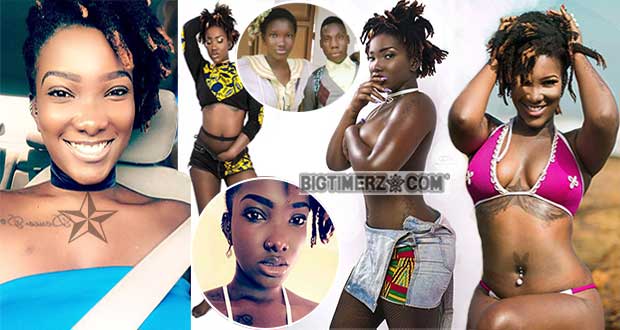Love Matters & Lifestyle

- Super User
- Category: Love & Lifestyle
- Saturday, 30 July 2016 11:37
6 incredible facts girls don't even know about their own ni'pples...
We all have ni'pples, those delightful little nubs. For many of us, they’re actually what’s called a secondary erogenous zone, especially for women, which means that stimulating them can send pleasurable feelings right down to the geni’tals.
Even so, some of us are very sensitive and others find their ni’pples are an absolute no-go zone. Wherever you find yourself on the spectrum, we believe these curious ni’pples facts will thrill you.
1. Your Ni’pples Are Perfect
No two ni’pples are alike. That means that the two ni’pples on your body may not be a mirror image of each other. This is normal.
The larger outer ring is your areola. For some women, the areola is light pink. For others, it can be darker and range from red to brown. For some women the areola becomes darker when they’re sexually excited. As a result, some cultures have even been known to paint their nipples to darken them in the hope of inspiring passion in their mates. Within the areola there can be little bumps. These bumps are the product of your Montgomery glands. These glands produce a protective, white, oily lubricant for the skin. This is also normal. Don’t squeeze those little bumps; they are there for a reason and opening them up can cause infection.
Females can grow hairs around their ni’pples . Our entire bodies are covered in fine, often almost invisible hair and sometimes a woman will have darker hairs that look almost like little eye lashes on the outer edge of the areola. These little hairs are more proof that you are normal.
2. Got Milk?
There are two features that are unique to mammals: our hair and our milk producing breasts. The scientific term for having ni’pples is mammillated. Each ni’pple has about 15 to 20 tiny openings. Some connect to milk ducts and some to the Montgomery glands I mentioned. The little whitish bumps you’re seeing let you know where some of these openings are.
Other animals, like goats and cows, have one reservoir called an udder. The milk discharges through an opening in the udder called a teat. Still more curious is the platypus. A platypus does not have nipples or teats. Her milk is secreted out of two round patches of skin on her belly. Weird, huh?
3. Headlights On
Erect ni’pples always draw our attention, although it is a misconception that erect ni’pples are an indication that a woman is se’xually aroused. (In other words, just because she’s got erect ni’pples doesn’t necessarily mean she’s raring to go!) Ni’pples become erect for many reasons, some of which are not se’xual in nature, like if you are cold, or if they get sensation from your clothing rubbing on them. And sometimes a woman’s ni’pples may not be erect even when she is se’xually excited.
Click on the next button below to continue...
4. Innie vs. Outie
Inverted ni’pples are fairly common. Anywhere from 10 to 20 percent of all women have them. An inverted ni’pple is caused by shorter-than-usual milk-bearing ducts in the br’east. Those ducts are attached to the ni’pple and, in these cases, prevent the ni’pple itself from projecting. So the ni’pple may lie flat or even push in a little rather than projecting out. Inverted ni’pples don’t pose any health risk, although they may be an obstacle to new mothers as they br’east-feed.
The easiest way to check whether your ni’pples are inverted is to gently pinch behind one, around the edges of the areola. If the ni’pple protrudes, it is not inverted. If your ni’pple is inverted it will actually retract into the br’east. If you have inverted ni’pples and are interested in correcting it, there are solutions. Gently rolling the nipple may do the trick. For pregnant women who need to correct inverted nipples for breastfeeding, check out a maternity shop for disks that attach to the ni’pples and are designed to be worn inside a bra. This simple device gently stretches the tissue and encourages the ni’pple to stand outward.
5. Evolutionary Awesomeness (or Trickery?)
Human females are the only mammals that develop br’easts and ni’pples that remain full and prominent, despite the fact that they are not lactating. Every other mammal only experiences prominent development during pregnancy and lactation. Scientists speculate that the human female’s full br’easts and erect ni’pples are a product of evolutionary development as species.
For other mammals, large breasts would be a sign that the female is lactating and not ovulating, and is therefore unavailable for procreation. Human females have developed ways of disguising when they are and are not fertile in order to confuse male mates and appear to be se’xually desirable even when they are not ovulating. But we’re also one of the few species that has s3x just for fun!
6. Triple Ni’pple
Every now and then, you’ll come across someone with an extra ni’pple – it’s not that uncommon! These “supernumerary” ni’pples are common in many species, including primates, rodents and ruminants. Guys have extra ni’pples more often than females; 1 in 18 males and 1 in about 50 females have extra ni’pples .
And a very select numbers of people have as many five or six ni’pples . Extra nipples usually run down the abdomen, along the milk line, but they have also been found on other locations, like on a person’s foot. Whether they’re big and bouncy or cute and pert, br’easts – and their ni’pples have a lot in common. But they’re also all a little bit different, and a little unique. That means you’ll have a little exploring to do, both with yourself, and with any new partner.
CREDIT: AP

















































































